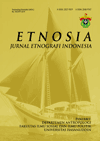Abstract
This paper is a description of daily activities in private companies related to the social relations in workplace between employee, management, as well as consumer. Dyadic social relationship is built based on the construction of agreement between individuals in that organization. The interaction which happened in the construction of agreement caused social relations that occur in certain period. The quality of social relations depends on how is the content of that agreement, which is certainly guided by values and norms that had been agreed. Therefore, agreement that established sustainably in dyadic social relationships caused a clique. This clique manifested in agreement, a similarity in thought and feeling in the activities either in the workplace or outside. Moreover, there are other parts in organization interactions such as an act of talk about the negative things of others, which make that people feel disturbed. The gossip could be in a negative labeling form which is given to an individual or group that caused a disharmony in social relations. The methods of collecting data are observation, in-depth interview, literature study and documents. The research results show that clique and gossip in a company workplace are closely related to the harmony and disharmony of workplace, also contribute in the performances of employee in particular and company in general.References
Agusyanto, R. (2010). Fenomena Dunia Mengecil, Jakarta, Institut Antropologi Indonesia
___________. (2014). Jaringan Sosial dalam Organisasi, Jakarta, PT. Raja Grafindo Persada.
Baba, M.L. (2006). Anthropology and Business; Encyclopedia of Anthropology. H.James Birx, Ed. Thousand Oaks, CA: Sage Publications.
Banerjee B.S., Chio, V.C.M., Mir, R. (2009). Organization, Markets and Imperial Formations; Towards an Anthropology Of Globalization, Massachusetts USA, Edward Elgard Publishing Limited.
Bhagat R.S, Steers, R.M. (edt). (2005). Cambrige Handbook of Cultural Organization and Work, Cambrige University Press, New York.
Brown, D.A. (1998). Organizational Culture.Great Britain: Pearson Education Limited.
Caulkins D.D., Jordan, T.A. (edt), (2013). A Companion to Organizational Anthropology, West Sussex UK, Wiley Blackwell.
Saifuddin, A.F. (2009). Antropologi Kontemporer, Jakarta, Gramedia Pustaka Utama.
Hallinan, M.T., Smith, S.S. (1989). Classroom Characteristics and Student Friendship Cliques, Journal. Vol.67, No.4.
Hornby, A.S. (1987). Oxford Advance Learner’s, Dictionary of Current English. England: Oxford University Press.
Jones,P. (2003), Pengantar Teori-Teori Sosial: Dari Teori Fungsionalisme Hingga Post-Modernisme, (trj.) Saifuddin, Jakarta: Pustaka Obor.
Khalisah S., Lubis, R. (2016). Perbedaan Perilaku Asertif Ditinjau Dari Pola Asuh Orang Tua Pada Remaja Yang Memiliki Clique, Jurnal Diversita, Program Studi Psikologi, Fakultas Psikologi, Universitas Medan Area, Issn 2461-1263 (Print), Issn: 2580-6793 (Online), Vol 1, No,1, 2016.
Kotter J.P & James, L., Heskett J.L. (1992). Corporate Culture & Performance (Free Press ), p. 11. www.amazon.com (ebook).
Moeran, B. (2005), The Business of Etnografi : Strategic Exchange, People and Organizations, Berg, New York.
Rouncefield, M.F. (2002). Business as Usual An Ethnography of Every Day (Bank) Works, Lancester Univercity, United Kingdom
Safriadi, (2017). Memenangkan Pasar Pembiayaan; Studi Kasus Strategi Bisnis PT. Armada Finance di Makassar, Jurnal Etnosia, Vol.2.No.1Juni 2017.
Soekanto, S. (2012). Sosiologi Suatu Pengantar. Jakarta: Raja Grafindo Persada.
Ully, C. (2012). LatarBelakang Terbentuknya Clique “The Allays” dan Faktor-FaktorYangMendorong Kekohesifan Antar Anggotanya, Jurnal Penelitian dan Pengukuran Psikologi, Vol.1, No.1, Okoteber 2012, Jurusan Psikologi, Fakultas Ilmu Pendidikan, Universitas Negeri Jakarta, Jakarta.





